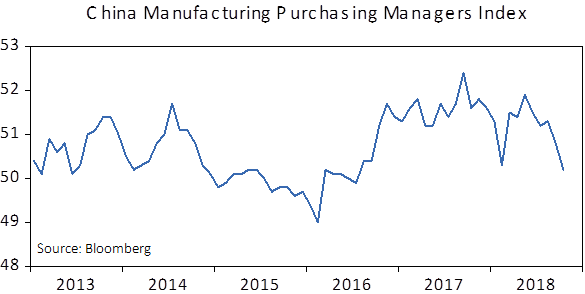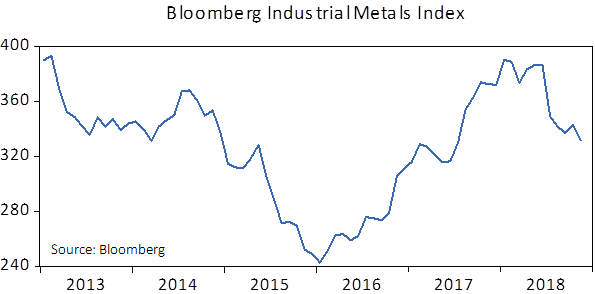Monday Morning Minute ~ November 19, 2018
November’s Data
If all you did was focus on the United States’ economy, you would conclude that October was a very good month. Over the past two weeks we learned that in October:
- Workers hourly wages shot up 3.1% from a year earlier, the best performance in a decade;
- U.S. Manufacturing activity remains solid (the Institute for Supply Management’s Purchasing Manager’s Survey is solidly in the 55-60 range);
- Core domestic retail sales are up a whopping 5%, year over year, continuing a very strong upward trend.
These sorts of readings are unmistakable positives for the United States’ economy, and in no way speak to a weaker outlook. This raises an obvious question. Why are markets behaving as they have the past few weeks?
Markets Weigh In
Throughout the past couple of months, markets have not been singing a happy tune. The Dow has lost over 1,000 points and corporate credit spreads have jumped to levels not seen since early 2016. Measures of risk aversion have spiked (CBOE VIX and the St. Louis Financial Stress Index). Safer and more stable companies (“risk off” stocks) have been outperforming riskier and more volatile ones (“risk on” stocks). Markets seem to be questioning whether the good times will continue, despite continued news about the U.S. economy.
But if we take a step back, we growing global risk-aversion — suggesting that issues are emanating from elsewhere. Most of the world’s stock markets are in the red this year, as output and growth forecasts are cut. As the chart below shows, Chinese Manufacturing, often seen as the “canary in the coal mine” for global output, is rolling over (Chart A, Below) and global prices for industrial metals are also off sharply (Chart B, below). Not surprisingly, the International Monetary Fund also recently trimmed its global growth forecast to 3.7% from 3.9% for both 2018 and 2019.
Chart A

Chart B

Mixed Bag
All-in-all, we view the last month’s jump in market volatility as out of step with the hard data we are getting on the U.S. economy. Most of that data, sometimes referred to as “fundamentals”, is more positive than just about any time since the cycle began. The strong economy has led to tightening capacity in some areas, a firming of inflation, and prompted the Federal Reserve to begin to remove the “punchbowl” by raising interest rates.
A key question is whether the recent “risk-off” mindset of traders spreads beyond financial markets into the “real” economy. As evidenced by recent data on the economy’s performance, we can say that worsened market sentiment has not hurt the “real” economy yet. A sustained and further widening of credit spreads, a further sustained fall in commodity prices, or a sustained pickup in equity market volatility could begin to impact business’ investment and consumer’s spending plans. We think the U.S. economy will grow faster than our 2.75% long-run growth forecast.
Portfolio Posture
Portfolio risk levels have already been reduced from above average to about average, beginning last spring due to a fall in our WCA Barometer. For core equity positioning, we are sticking with tactical calls to remain overweight domestic versus foreign; developed versus emerging; and value over growth.
For more on our WCA Fundamental Conditions Barometer and long-term capital market assumptions, please click here.
Kevin Caron,
CFA, Senior Portfolio Manager
Chad Morganlander, Senior Portfolio Manager
Matthew Battipaglia, Portfolio Manager
Suzanne Ashley, Analyst
(973) 549-4168
www.washingtoncrossingadvisors.com
www.stifel.com
Disclosures
WCA Fundamental Conditions Barometer Description: We regularly assess changes in fundamental conditions to help guide near-term asset allocation decisions. The analysis incorporates approximately 30 forward-looking indicators in categories ranging from Credit and Capital Markets to U.S. Economic Conditions and Foreign Conditions. From each category of data, we create three diffusion-style sub-indices that measure the trends in the underlying data. Sustained improvement that is spread across a wide variety of observations will produce index readings above 50 (potentially favoring stocks), while readings below 50 would indicate potential deterioration (potentially favoring bonds). The WCA Fundamental Conditions Index combines the three underlying categories into a single summary measure. This measure can be thought of as a “barometer” for changes in fundamental conditions.
The information contained herein has been prepared from sources believed to be reliable but is not guaranteed by us and is not a complete summary or statement of all available data, nor is it considered an offer to buy or sell any securities referred to herein. Opinions expressed are subject to change without notice and do not take into account the particular investment objectives, financial situation, or needs of individual investors. There is no guarantee that the figures or opinions forecasted in this report will be realized or achieved. Employees of Stifel, Nicolaus & Company, Incorporated or its affiliates may, at times, release written or oral commentary, technical analysis, or trading strategies that differ from the opinions expressed within. Past performance is no guarantee of future results. Indices are unmanaged, and you cannot invest directly in an index.
Asset allocation and diversification do not ensure a profit and may not protect against loss. There are special considerations associated with international investing, including the risk of currency fluctuations and political and economic events. Investing in emerging markets may involve greater risk and volatility than investing in more developed countries. Due to their narrow focus, sector-based investments typically exhibit greater volatility. Small company stocks are typically more volatile and carry additional risks, since smaller companies generally are not as well established as larger companies. Property values can fall due to environmental, economic, or other reasons, and changes in interest rates can negatively impact the performance of real estate companies. When investing in bonds, it is important to note that as interest rates rise, bond prices will fall. High-yield bonds have greater credit risk than higher-quality bonds. The risk of loss in trading commodities and futures can be substantial. You should therefore carefully consider whether such trading is suitable for you in light of your financial condition. The high degree of leverage that is often obtainable in commodity trading can work against you as well as for you. The use of leverage can lead to large losses as well as gains.
All investments involve risk, including loss of principal, and there is no guarantee that investment objectives will be met. It is important to review your investment objectives, risk tolerance and liquidity needs before choosing an investment style or manager. Equity investments are subject generally to market, market sector, market liquidity, issuer, and investment style risks, among other factors to varying degrees. Fixed Income investments are subject to market, market liquidity, issuer, investment style, interest rate, credit quality, and call risks, among other factors to varying degrees.
This commentary often expresses opinions about the direction of market, investment sector and other trends. The opinions should not be considered predictions of future results. The information contained in this report is based on sources believed to be reliable, but is not guaranteed and not necessarily complete.
The securities discussed in this material were selected due to recent changes in the strategies. This selection criteria is not based on any measurement of performance of the underlying security.
Washington Crossing Advisors LLC is a wholly owned subsidiary and affiliated SEC Registered Investment Adviser of Stifel Financial Corp (NYSE: SF).



